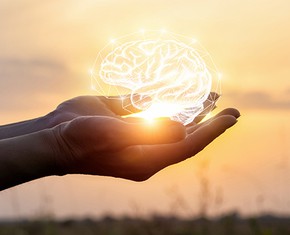The views expressed in our content reflect individual perspectives and do not represent the authoritative views of the Baha'i Faith.
Mark Twain said “Anger is an acid that can do more harm to the vessel in which it is stored than to anything on which it is poured.” Do you store your anger up like acid?
Think about it this way: when was the last time you got really enraged? Reflect on that question for a minute and try to remember. While you’re recalling about it, let’s examine how the mechanism of human anger works.
Originally, the word “anger” came from the Latin rabies, which means “rage and fury.” If you’ve ever seen a rabid animal, you’ll immediately understand the origin of the term. The Baha’i teachings warn us about anger, and even say that it symbolically “burns” the liver the same way acid corrodes its container:
Jealousy consumeth the body and anger doth burn the liver: avoid these two as you would a lion. – Baha’u’llah, quoted in Dr. J. E. Esselmont’s Baha’u’llah and the New Era, p. 108.
Like animals, every human being can become enraged. It happens to all of us. We get so mad, so furious that anger takes control of our bodies, our brains and our actions.
So where does that rage come from? Biochemists and neuroscientists have studied rage, and discovered that it starts in the hypothalamus, that almond-sized, innermost portion (along with the amygdala) of every vertebrate’s primitive brain. The hypothalamus—what some scientists call our “primitive” brain—controls our body temperature, our hunger, our sleep cycles, our sexual drives and our fear-based fight-or-flight responses.
These responses work in amazing ways. For example: even in mice that have never seen a cat before, the hypothalamus instantly produces a hormone that causes the mouse to flee in terror at the first sight of a feline predator. This core mechanism, which works immediately whenever any mammal faces a threatening situation, floods our brain with adrenalin and corticosteroids. Those hormones make us want to run away from danger—or conversely, to confront and fight it.
When the hypothalamus makes the snap decision to confront perceived threats or danger, several things occur at once. The brain immediately pumps hormones like vasopressin and oxytocin into the limbic system; the pituitary gland releases massive amounts of adrenocorticotropic hormone; which then makes the adrenal cortex quickly pump adrenalin into our nervous systems. When all that happens, those powerful hormones temporarily increase our physical strength. Adrenalin dulls pain sensations and slows down our time perceptions, which is why people in violent rages report experiencing things in slow-motion.
However, those same hormones also drastically reduce our ability to think rationally. We temporarily lose our ability to reason, our prudence and our restraint. Our vision narrows and our hearing diminishes. We “see red”—some people actually do experience a pinkish tinge to their vision when rage overtakes them. Arms and legs can shake and tremble from the sudden flood of adrenaline and oxygen in the bloodstream. The heart rate increases rapidly, and we hyperventilate. All of these hormonal effects can make us strike out violently, attacking the source of our rage.
As everyone knows, this kind of raging anger can have terrible, permanent, destructive consequences. It can destroy relationships, damage everyone who witnesses it, and injure or kill others. Rage negatively impacts the health of the angry person, too—studies have shown that it leads to a highly increased risk of heart attack and stroke.
Now that we’ve learned a little about the science of anger, did you remember the last time you got really mad? If so, think back on that moment, and recall what you actually did with your anger. Did it spill over into fury and take itself out on someone else? Or did it harden your resolve to do something positive; to try to deal with the root cause of your rage? Did it turn destructive, or were you able to turn it to constructive ends?
Yes, anger can sometimes serve a positive purpose—if we find ways to focus it on the causes of injustice, tyranny and human suffering. Directed against the world’s welter of unjust oppression, righteous anger can spur people to take positive action and create change. Most movements and social reform programs started when someone got justifiably angry and determined to do something about a fundamentally unfair situation.
So, when we first feel it happening, how do we deal with our destructive anger? Since all of us have the capacity for anger and even rage inside us, what inner practice can we adopt that will calm and take charge of that slumbering beast within? What can a person do—morally, intellectually and spiritually—to quell and control rage and anger, and turn them towards better, more constructive ends?
First, rather than viewing your own inner anger as somehow an “evil” force, the Baha’i teachings recommend thinking about human anger this way:
In the innate nature of things there is no evil—all is good. This applies even to certain apparently blameworthy attributes and dispositions which seem inherent in some people, but which are not in reality reprehensible. For example, you can see in a nursing child, from the beginning of its life, the signs of greed, of anger, and of ill temper; and so it might be argued that good and evil are innate in the reality of man, and that this is contrary to the pure goodness of the innate nature and of creation. The answer is that greed, which is to demand ever more, is a praiseworthy quality provided that it is displayed under the right circumstances. Thus, should a person show greed in acquiring science and knowledge, or in the exercise of compassion, high-mindedness, and justice, this would be most praiseworthy. And should he direct his anger and wrath against the bloodthirsty tyrants who are like ferocious beasts, this too would be most praiseworthy. But should he display these qualities under other conditions, this would be deserving of blame.
It follows therefore that in existence and creation there is no evil at all, but that when man’s innate qualities are used in an unlawful way, they become blameworthy. – Abdu’l-Baha, Some Answered Questions, newly revised edition, pp. 248-249.
So let’s see if we can discover, in the subsequent essays in this series, some constructive ways to channel our potentially destructive anger, frustration and rage—to transform it into a spiritual force.
















Comments
Sign in or create an account
Continue with Googleor